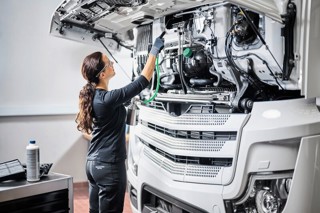By Kasia Chodurek, director of business development at Aegis Energy
This year’s Mental Health Awareness Week (May 12-18) focuses on community, recognising social connection's important role in our well-being.
With this in mind, there has never been a more prudent time to highlight the vital, but often lonely, work that HGV drivers do, and how we can better support them.
Current statistics present a sobering reality: 44% of HGV drivers suffer from depression, and 41% are planning to leave their job in the next year, painting a picture of a workforce suffering from mental health issues at a significantly higher rate than average.
For too many HGV drivers in the UK, who spend long hours on the road, often isolated, community is something that can sometimes feel out of reach. We thrive when we feel connected. When we’re part of something bigger. When we know we’re supported.
Thankfully, awareness of this issue is growing, partially spurred on by a chronic shortage of drivers.
As the UK’s transition to clean commercial transport begins to take shape, and the vital role of HGV drivers is again made clear, we have a unique opportunity to rebuild the commercial transport system with driver well-being and community at its core.
After all, we want the future to be powered not just by low-carbon fuels, but by healthy and happy people connected to their work, and each other.
Driving factors
When we examine the typical working patterns of HGV drivers, it is not hard to see what might be causing this trend.
Most drivers work long and irregular hours, under intense time pressure. By nature, much of these hours will be spent in isolation, and the few situations where drivers do interact with people face-to-face may be brief and transactional.
The working environment for drivers can also lack the conditions needed to support well-being. Many rest stops are unclean, unpleasant, and typically offer few safe places to recuperate.
The physical and mental toll of the role cannot be separated. Drivers are physically sedentary for much of their day, and often have limited healthy food options available to them.
A lack of rest, exercise, nutrition, and social interaction is a dangerous cocktail for anyone’s mental and physical health.
The logistics industry is also 95% male, meaning many that suffer are those least likely to share and seek help for their issues, exacerbating the situation further.
The consequences
The effects of these factors have been inevitably severe. High rates of burnout, depression, and turnover are common across the industry.
As demand for fast and efficient delivery increases, and the number of drivers fails to keep pace, the remaining drivers and ultimately fleet operators will face even greater pressure to maintain the flow of supply chains.
The mental health charity, Mind, found that as much as 30% of illnesses in the transport and logistics sector are mental, with some estimating that the real proportion could be much higher.
At its darkest point, the mental health crisis for drivers can become lethal; research by another mental health charity found that HGV drivers have a 20% higher suicide rate than the national average. It’s therefore crucial that those who remain feel valued and respected in their work.
Drivers in mind
Optimistically, some action has already been taken to address the issue, such as the establishment of Mates In Mind, an organisation providing dedicated education, resources, and crisis support to those working in transport & logistics.
The charity has partnered with a range of companies in the transport sector, many of which have reported positive initial developments related to employee wellbeing and support.
Advice is also increasingly being passed on to fleet operators regarding the benefits of these kinds of efforts.
A 2023 Government-funded report from the National Centre for Social Research suggested that improving workplace support and culture could significantly boost recruitment and retention in the industry.
Whilst policy and infrastructure have historically focused on vehicles and efficiency, there’s a growing recognition of the need to design with people in mind too.
Yet the environment that drivers operate in is still largely incompatible with well-being. Without additional and continued action, these challenges will persist. HGV drivers will continue to suffer physically and mentally, and the industry will remain locked in a struggle for recruitment and retention.
Transitioning to a new standard
The issue of driver well-being has never been more salient. Fleet owners and operators, recognising the benefits of early action, are increasingly investing in a clean future for the industry.
Large-scale investment and redesign of infrastructure is underway, catering to a low-carbon, multi-fuel future. This offers us a unique opportunity to create new spaces where drivers feel safe, respected and valued.
This infrastructure will not only be tailored to the clean refuelling requirements of even the largest trucks and vans, but it will also be built explicitly with drivers in mind.
With clean toilets and showers, good food and calm spaces, these hubs will aim to reset the refuel station standard for driver well-being.
A thriving commercial transport sector depends on healthy drivers, and the upcoming energy transition is an opportunity to build this commitment into the fabric of the sector and put drivers first.



















Login to comment
Comments
No comments have been made yet.